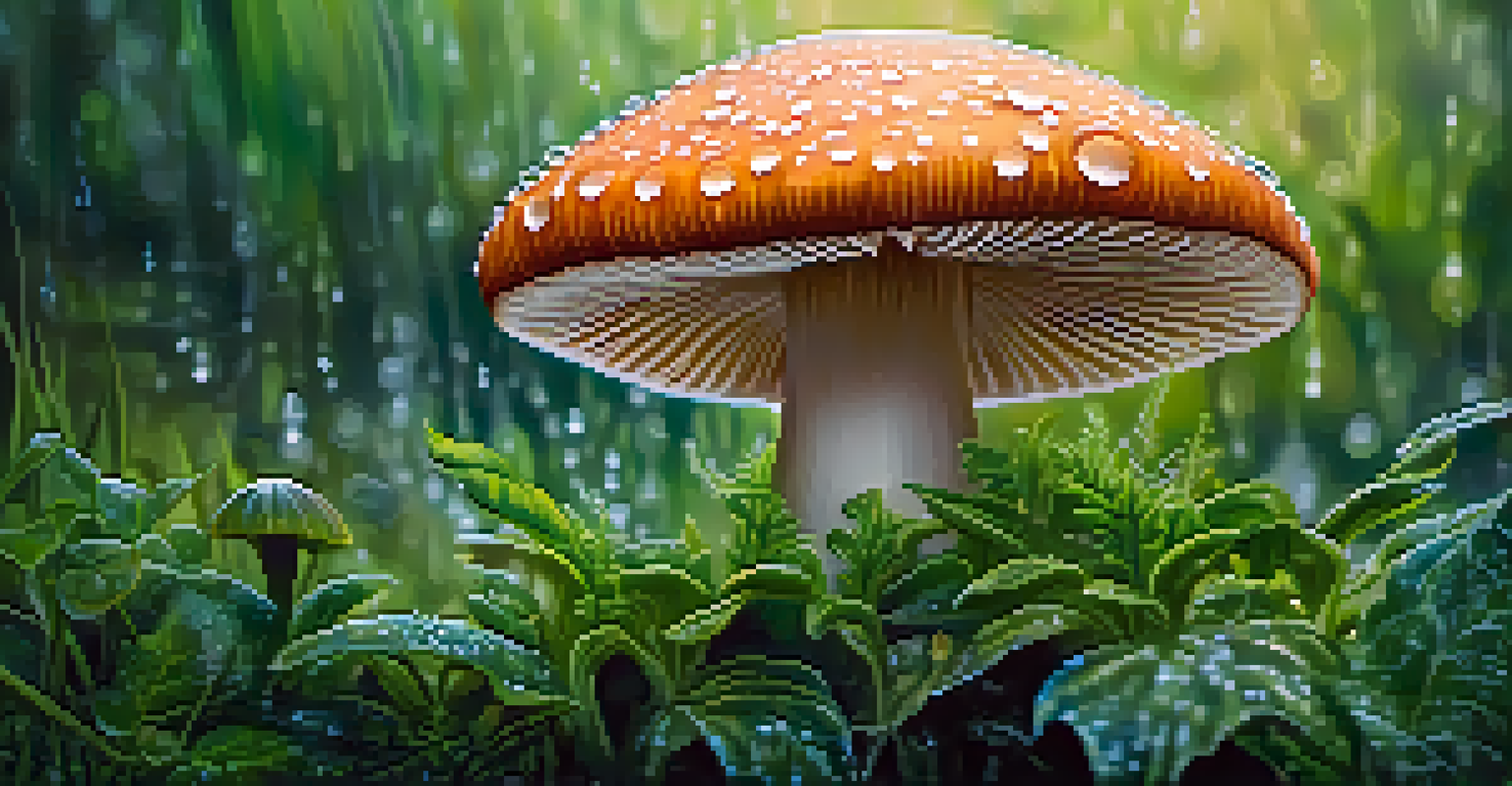Entheogens: Their Effects on Sleep and Dream States

What Are Entheogens and Their Historical Use?
Entheogens are substances that are often used in spiritual or religious contexts to induce altered states of consciousness. Common examples include psilocybin mushrooms and ayahuasca, both of which have deep cultural roots in various indigenous practices. Historically, these substances were seen as gateways to the divine, used to enhance spiritual experiences and connect with a higher power.
Psychedelics can help us understand that we are not separate from the world around us; we are part of a larger whole.
As societies evolved, the understanding and use of entheogens shifted, leading to both reverence and stigma. In recent years, there's been a resurgence of interest in their potential therapeutic benefits, particularly in mental health and well-being. This renewed focus brings to light their impact not only on consciousness but also on physiological processes, including sleep and dreams.
In essence, entheogens serve as a bridge between ancient wisdom and modern science, prompting a deeper exploration of their effects on the human psyche, especially regarding our nightly rest and the dreams that accompany it.
How Entheogens Influence Sleep Patterns
Entheogens can significantly impact sleep patterns, often altering how we enter and experience different sleep stages. For instance, some users report that substances like LSD or psilocybin can either disrupt sleep or lead to unusual sleeping patterns, resulting in less time spent in deep sleep. This shift can be both intriguing and unsettling, as it may lead to more vivid dreams or, conversely, fragmented rest.

Moreover, the timing and dosage of entheogen consumption play crucial roles in determining these effects. If taken too late in the day, the stimulating properties of some entheogens can delay sleep onset, while lower doses may lead to a more restful night. Understanding these nuances helps us appreciate the delicate balance between enjoyment and the potential costs to our sleep health.
Entheogens Enhance Dream Experiences
Entheogens can lead to more vivid and emotionally charged dreams by influencing neurotransmitters like serotonin.
Ultimately, while entheogens can enhance the dream experience, they may also challenge the quality of sleep, leading to a complex interplay that varies from person to person.
The Connection Between Entheogens and Dreaming
Many users of entheogens report experiencing heightened dream activity, often describing their dreams as more vivid, surreal, or emotionally charged. This phenomenon can be attributed to the way these substances interact with neurotransmitters in the brain, particularly serotonin. By influencing serotonin receptors, entheogens can enhance dream recall and create more elaborate dream landscapes.
The mind is like a parachute. It doesn’t work if it isn’t open.
Additionally, dreams induced or influenced by entheogens can provide insights into our subconscious thoughts, fears, and desires. This capacity for self-reflection can be particularly valuable for individuals seeking personal growth or healing. In essence, entheogens may act as a catalyst for deeper understanding through the dream state, allowing users to explore their inner worlds in ways they might not have thought possible.
However, it's important to approach these experiences with caution, as not all dream encounters will be pleasant. The intensity of emotions experienced during these dreams can sometimes lead to unsettling or challenging reflections.
Potential Therapeutic Benefits of Entheogens on Sleep
Research is increasingly showing that certain entheogens may have therapeutic potential for improving sleep-related issues. For example, studies suggest that substances like psilocybin can help alleviate anxiety and depression, both of which are known to disrupt sleep. By addressing the underlying mental health concerns, users may find themselves sleeping better and dreaming more peacefully.
Furthermore, the therapeutic use of entheogens in controlled settings has provided insights into their potential to enhance emotional well-being. Individuals undergoing guided sessions often report significant reductions in nightmares and other sleep disturbances, indicating a possible pathway for healing. This suggests a dual benefit: not only do users experience a more restful sleep, but they also gain valuable insights from their dreams.
Therapeutic Potential for Sleep Issues
Research indicates that certain entheogens may alleviate anxiety and depression, improving sleep quality and reducing disturbances.
As the field of psychedelic research expands, we may discover even more ways in which these substances can positively influence our sleep and dream experiences, paving the way for innovative treatments in sleep medicine.
Cautions and Considerations When Using Entheogens
While the exploration of entheogens can be exciting, it is essential to approach their use with caution. Not everyone responds positively to these substances; some may experience anxiety, paranoia, or other adverse effects. Additionally, the setting in which entheogens are consumed plays a crucial role in the overall experience, making it vital to ensure a safe and supportive environment.
Moreover, certain individuals, particularly those with a history of mental health disorders, should be especially mindful of the potential risks. It's advisable to consult with a healthcare professional before diving into the world of entheogens, particularly if sleep disturbances are a concern. Open dialogue and education can play a significant role in ensuring a responsible approach to their use.
Ultimately, understanding one’s own mental and physical health, as well as the broader implications of entheogen use, is key to navigating this complex terrain safely.
The Role of Set and Setting in Entheogen Experiences
One of the most important aspects of using entheogens is the concept of 'set and setting.' 'Set' refers to the mindset or mental state of the individual, while 'setting' encompasses the physical and social environment in which the substance is consumed. Together, these factors can heavily influence the overall experience, including sleep and dreaming.
For instance, an individual who approaches entheogen use with curiosity and openness may have a vastly different experience compared to someone who is anxious or fearful. Likewise, a calm, safe environment can enhance positive effects, while a chaotic or uncomfortable setting can lead to distressing experiences. This highlights the importance of preparing both mentally and physically for the journey ahead.
Importance of Set and Setting
The mindset and environment in which entheogens are used significantly affect the overall experience and outcomes, including sleep and dreams.
Understanding and optimizing set and setting can empower users to shape their experiences, potentially leading to more profound insights and peaceful sleep, ultimately enriching the journey into their dream states.
Final Thoughts on Entheogens and Sleep Exploration
Exploring the relationship between entheogens, sleep, and dream states opens up a fascinating dialogue about consciousness and healing. As more people turn to these substances for self-discovery and therapeutic benefits, it’s crucial to remain informed about their potential effects on sleep patterns and dreaming. This knowledge can empower individuals to make choices that align with their health and wellness goals.
While the allure of vivid dreams and altered states can be enticing, it’s vital to approach entheogen use with mindfulness and respect. Understanding the complexities of how these substances interact with our bodies and minds allows for a more enriching and safe experience. As we continue to learn from both ancient practices and modern science, the potential for personal growth through entheogens becomes increasingly clear.

In the end, whether you’re seeking deeper insights into your dreams or simply looking to enhance your overall well-being, understanding the effects of entheogens on sleep is an enlightening journey worth taking.